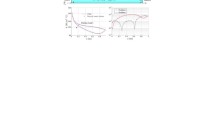Abstract
Turbulent penetration can occur when hot and cold fluids mix in a horizontal T-junction pipe at nuclear plants. Caused by the unstable turbulent penetration, temperature fluctuations with large amplitude and high frequency can lead to time-varying wall thermal stress and even thermal fatigue on the inner wall. Numerous cases, however, exist where inner wall temperatures cannot be measured and only outer wall temperature measurements are feasible. Therefore, it is one of the popular research areas in nuclear science and engineering to estimate temperature fluctuations on the inner wall from measurements of outer wall temperatures without damaging the structure of the pipe. In this study, both the one-dimensional (1D) and the two-dimensional (2D) inverse heat conduction problem (IHCP) were solved to estimate the temperature fluctuations on the inner wall. First, numerical models of both the 1D and the 2D direct heat conduction problem (DHCP) were structured in MATLAB, based on the finite difference method with an implicit scheme. Second, both the 1D IHCP and the 2D IHCP were solved by the steepest descent method (SDM), and the DHCP results of temperatures on the outer wall were used to estimate the temperature fluctuations on the inner wall. Third, we compared the temperature fluctuations on the inner wall estimated by the 1D IHCP with those estimated by the 2D IHCP in four cases: (1) when the maximum disturbance of temperature of fluid inside the pipe was 3°C, (2) when the maximum disturbance of temperature of fluid inside the pipe was 30°C, (3) when the maximum disturbance of temperature of fluid inside the pipe was 160°C, and (4) when the fluid temperatures inside the pipe were random from 50°C to 210°C.
Similar content being viewed by others
References
Dou, R., et al., Experimental study on heat-transfer characteristics of circular water jet impinging on hightemperature stainless steel plate. Applied Thermal Engineering, 2014. 62(2): p. 738–746.
Liu, W. and K. Takase, Development of measurement technology for surface heat fluxes and temperatures. Nuclear Engineering and Design, 2012. 249: p. 166–171.
LU, T., LIU B., and JIANG P.X., Inverse estimation of the inner wall temperature fluctuations in a pipe elbow. Applied Thermal Engineering, 2011. 31(11–12): p. 1976–1982.
Lu, T., et al., A two-dimensional inverse heat conduction problem in estimating the fluid temperature in a pipeline. Applied Thermal Engineering, 2010. 30(13): p. 1574–1579.
Mansour, S., É. Canot, and M. Muhieddine, Identification of the Thermophysical Properties of the Soil by Inverse Problem. Journal of Heat Transfer, 2016. 138(9)
Huang, C.-H. and H.-M. Hsu, An inverse problem in determining the optimal filler shape of composite materials for maximum effective thermal conductivity. International Journal of Heat and Mass Transfer, 2015. 80: p. 98-106.
Xu, D. and P. Cui, Simultaneous determination of thickness, thermal conductivity and porosity in textile material design. Journal of Inverse and Ill-posed Problems, 2016. 24(1).
Zhang, Q., et al., Determination of temperature dependent thermophysical properties using an inverse method and an infrared line camera. International Journal of Heat and Mass Transfer, 2016. 96: p. 242–248.
Bouache, T., H. Pron, and D. Caron, Identification of the Heat Losses at the Jaws of a Tensile Testing Machine. Experimental Mechanics, 2015. 56(2): p. 287–295.
Mohammadiun, M., Time-Dependent Heat Flux Estimation in Multi-Layer Systems by Inverse Method. Journal of Thermophysics and Heat Transfer, 2016. 30(3): p. 599–607.
Braiek, A., et al., Estimation of radiative and conductive properties of a semitransparent medium using genetic algorithms. Measurement Science and Technology, 2016. 27(6): p. 065601.
Zhao, J., et al., Inverse determination of thermal conductivity in lumber based on genetic algorithms. Holzforschung, 2016. 70(3).
Cimrák, I., Inverse thermal imaging in materials with nonlinear conductivity by material and shape derivative method. Mathematical Methods in the Applied Sciences, 2011. 34(18): p. 2303–2317.
Mulcahy, J.M., et al., Heat flux estimation of a plasma rocket helicon source by solution of the inverse heat conduction problem. International Journal of Heat and Mass Transfer, 2009. 52(9–10): p. 2343–2357.
Huang, C.-H., I.C. Yuan, and H. Ay, A three-dimensional inverse problem in imaging the local heat transfer coefficients for plate finned-tube heat exchangers. International Journal of Heat and Mass Transfer, 2003. 46(19): p. 3629–3638
Acknowledgement
This work was supported by the National Natural Science Foundation of China (Project No. 51276009), and Program for New Century Excellent Talents in University (No. NCET-13-0651).
Author information
Authors and Affiliations
Additional information
This work was supported by the National Natural Science Foundation of China (Project No. 51276009), and Program for New Century Excellent Talents in University (No. NCET-13-0651).
Rights and permissions
About this article
Cite this article
Guo, Z., Lu, T. & Liu, B. Inverse heat conduction estimation of inner wall temperature fluctuations under turbulent penetration. J. Therm. Sci. 26, 160–165 (2017). https://doi.org/10.1007/s11630-017-0925-8
Received:
Published:
Issue Date:
DOI: https://doi.org/10.1007/s11630-017-0925-8




